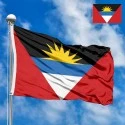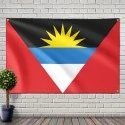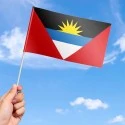The national flag of Antigua and Barbuda is a vibrant and dynamic symbol that tells the story of the nation, its struggle for freedom, and its hopes for the future. Adopted in 1967, the flag's unique design reflects the country's natural beauty, its African heritage, and its aspiration for progress. The flag is a powerful source of national pride, embodying the spirit and vitality of its people.
A Detailed Look at the Flag's Design and Symbolism
The flag of Antigua and Barbuda is a visually striking design, incorporating a rich array of colours and symbols. The flag is a vertical triband with three horizontal stripes of black, blue, and white, interrupted by a golden rising sun. The overall shape is a large, inverted triangle, or a "V," at the bottom. This complex design is unique among world flags and is packed with deep symbolic meaning.
Each element of the flag carries a significant message, reflecting the core principles and identity of the Antiguan and Barbudan nation:
-
The Rising Sun: The seven-point golden sun is the flag’s most prominent feature. It symbolises the dawn of a new era, representing the nation's fresh start and its radiant future. It also signifies the sun that blesses the islands with its warmth and light, which is crucial for tourism.
-
Red: The red field of the flag represents the energy and dynamism of the Antiguan and Barbudan people. It stands for the lifeblood of the nation, the people's resilience, and their willingness to fight for their freedom.
-
Black: The black field at the top of the flag symbolises the African heritage of the people of Antigua and Barbuda, who make up the majority of the population. It represents the soil, the fertile ground from which the nation grows, and the strength of the people.
-
Blue: The central blue stripe represents hope and the Caribbean Sea that surrounds the islands. It signifies the calm beauty of the waters and the hope for a bright future.
-
White: The two white triangles at the bottom represent the sand of the beautiful beaches that are famous worldwide. It also symbolises hope and purity.
-
The "V" Shape: The overall V-shape of the red and black stripes coming together in the center is said to symbolise "Victory," a nod to the nation's triumph over colonialism.
The History and Adoption of the Flag
The history of the Antiguan and Barbudan flag is directly tied to the country's journey toward self-governance. In 1967, when the country became an Associated State of the United Kingdom, a national competition was held to design a new flag. The winning design was submitted by a local art teacher, Reginald Samuel. His design was chosen from over 600 entries for its powerful symbolism and aesthetic appeal.
The flag was officially adopted and hoisted for the first time on February 27, 1967, to mark the occasion of the country’s new constitutional status. Although Antigua and Barbuda later gained full independence on November 1, 1981, the flag's design was kept, solidifying its place as a cherished national symbol.
Meaning and Significance for Citizens
For the people of Antigua and Barbuda, the flag is more than a national emblem; it is a sacred symbol of their identity, resilience, and sovereignty. It represents the successful struggle for self-determination and the collective aspiration for a prosperous future. The flag is proudly displayed during national holidays, especially on Independence Day, and serves as a constant reminder of the nation’s rich heritage, its natural beauty, and its bright future. The unique design and the story of its creation by a local citizen make it a deeply personal and meaningful symbol for all Antiguans and Barbudans.
Interesting Facts
-
The flag was designed by Reginald Samuel, a secondary school art teacher, who won the national competition. His design was chosen out of 600 entries.
-
The seven points of the sun represent the seven parishes of Antigua and Barbuda.
-
The flag’s design, with the rising sun, is meant to be a constant symbol of hope and progress for the nation, a "new dawn."
-
The black colour on the flag is a direct tribute to the African ancestors of the majority of the population, acknowledging their heritage and strength.
-
The "V" shape formed by the stripes is also a subtle nod to the word "Victory" over colonialism.
-
The flag is used in two different forms: the civil flag and the state flag. Both are identical in design, but the state flag is used by the government and official bodies, while the civil flag is used by citizens.
In the demonstration images, full-size flags are shown with proportions of 2:3, and hand-held flags with proportions of 1:2.









 Waving flag
Waving flag
 Sizes:
Sizes:
 Round flag
Round flag
 Sizes:
Sizes:
 Rectangular flag 2:3
Rectangular flag 2:3
 Sizes:
Sizes: